accueil site > 45. Archives > Paysage et patrimoine > 01. Teaching materials > 05. All level > Gardens of mythology
-
45. Archives
-
Paysage et patrimoine
-
01. Fiches pédagogiques
Disciplines
-
01. Teaching materials
Disciplines
-
02. Jardin sans frontière : une école pour développer les compétences -clés en Europe
- 04. Partenaires
- 05. Rencontres transnationales
- 14. À l’école du jardin. Mobilités de formation dans les jardins d’Europe
- 15. À l’école européenne du jardin. Paroles de formateurs sur leurs formations "entre pairs"
- 16. A l’école auropéenne du jardin. Paroles d’apprenants sur leurs mobilités Erasmus+
- 19. Petit glossaire "européen" du jardin
- 20. Dissémination
- 21. Exploitation locale du projet
- 03. Un nouvel Erasmus+ : Le bleu européen comme étendard contre l’exclusion des adultes
-
09. Erasmus+ partenariato
-
Cammini del Blu in Europa
- 01. Incontri transnazionali
- 05. Progetti blu di partners
- 10. Percorsi europei del Blu
- 20. Storie blu
- 40. Disseminazione
- 43. Transcultural Carpet Blue
- 45. Missive blu
- 46. Glossario blu
- 47. Schede didattiche "Pedagogia del colore blu in Europa"
- 48. Illustrazioni delle schede didattiche : Mostra delle opere degli studenti
-
Giardino senza frontiere. Una scuola per lo slivuppo di competenze chiave in Europa
- 04. Partners
- 05. Riunioni transnazionali
- 14. Alla scuola del giardino. Mobilità di formazione nei giardini d’Europa
- 15. Alla scuola del Giardino. Parole di formatori sul loro addestramento "tra pari"
- 16. Alla scuola del giardino. Parole dei discenti sul loro Erasmus + Mobilità
- 19. Piccolo glossario europeo del giardino
-
Cammini del Blu in Europa
-
11. Erasmus+ Partnership
- 01. Transnational Meetings
- 05. Blue Projects of partners
- 07. European roads of the Blue
- 10. Blue stories
- 40. Dissemination
- 43. Transcultural Carpet Blue
- 45. Blue Missives
- 46. Blue Glossary
- 48. Roads of the blue : the file
- 50. Illustrations of the pedagogic file : exhibition of works of learners
-
51. Garden Without Borders : A School for Developing Key Competences in Europe
- 04. Partners
- 05. Transnational meetings
- 14. At Garden School. Training mobilities in the gardens of Europe
- 15. At Garden School. Words of trainers on their "peer-to-peer" training
- 16. At Garden School. Learners’ words about their mobility Erasmus +
- 19. Small European glossary of the garden
- 20. Dissemination
-
11. Partenariats Erasmus+
-
01. Les chemins du bleu en Europe
- 01. Rencontres transnationales
- 05. Projets bleus des partenaires
- 10. Routes du Bleu en Europe ...
- 20. Histoires Bleues
- 40. Dissémination
- 43. Transcultural Carpet Blue
- 45. Missives bleues
- 46. Glossaire bleu
- 47. Formation pédagogique : fiches pédagogiques et référentiel de compétences clés et transversales
- 50. Illustrations des fiches pédagogiques : exposition des travaux des apprenants
-
01. Les chemins du bleu en Europe
- 12. Pedagogic tools
- 17. Fiches pédagogiques
- 17. Schede Pedagogiche
-
01. Fiches pédagogiques
- 05. Livre d’or des formations
- 07. Livre d’or des formations Comenius - Grundtvig
- 10. National
- 20. International
-
Paysage et patrimoine
Gardens of mythologydimanche 16 novembre 2008
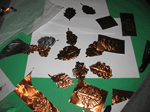 PROJECT
PROJECT
To create a knowledge of the theme of the garden in mythical and historical terms which can educate pupils about both the “beautiful and good and the “equal and different ? in every day life, recognising “the garden ? which surrounds us with the aim of tending all aspects of it with care and respect within the framework of a common project.
OBJECTIVES
![]() To bring the mythical universe, which is constantly present in art as in everyday life, closer through appropriate comprehension keys
To bring the mythical universe, which is constantly present in art as in everyday life, closer through appropriate comprehension keys
![]() To practise interpreting the symbology, the “second sense ? of the myth.
To practise interpreting the symbology, the “second sense ? of the myth.
![]() to respond to the demands of the interdisciplinary nature of scholastic programs which, while giving space to mythology in its various disciplines e.g. art, literature, and history, need moments to gather together and share the various aspects of mythology in order to follow a broader vision of reality.
- To interpret the “second sense ? of the environment of life and landscape.
to respond to the demands of the interdisciplinary nature of scholastic programs which, while giving space to mythology in its various disciplines e.g. art, literature, and history, need moments to gather together and share the various aspects of mythology in order to follow a broader vision of reality.
- To interpret the “second sense ? of the environment of life and landscape.
SKILLS
![]() To study the links and the cultural heritage which together make up our common patrimony.
To study the links and the cultural heritage which together make up our common patrimony.
![]() To appreciate our cultural and natural patrimony, creating an awareness of the correct behaviour with regard to its conservation and bringing us closer to the earth.
To appreciate our cultural and natural patrimony, creating an awareness of the correct behaviour with regard to its conservation and bringing us closer to the earth.
![]() To learn to discern, through the various forms of “diversity ? which are part of our lives, a source of richness rather than a reason for confrontation.
To learn to discern, through the various forms of “diversity ? which are part of our lives, a source of richness rather than a reason for confrontation.
MATERIALS
![]() rectangular sheets of material
rectangular sheets of material
![]() acrylic colours for the background
acrylic colours for the background
![]() acorns that were dried and then painted gold
acorns that were dried and then painted gold
![]() sheet of copper for the leaves
sheet of copper for the leaves
![]() extra-strong glue
extra-strong glue
![]() glitter
glitter
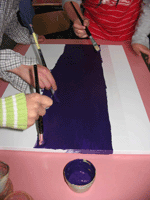
REFERENCES
1. The garden of Eden
(Literary references : Genesis 2. 8-15 : Koran, sure 37. 76. Iconographic references : Assyrian bas-relief with the tree of life, by Nimrud, dating back to 883-859 B.C, conserved in Paris, Louvres Museum ; “The garden of delight ? by J. Bosch, conserved in Madrid, Prado Museum).
2. The garden of the Esperidi
(Literary references : Diodoro Siculo, Biblioteca Storica 4. 26. 2 ; Pseudo-Hyginus, Astronomica 2. 3 ; Euripides, Ippolito, 742 ss ; Apollodoro, Biblioteca 2. 113-4 ; Pausania, Description of Greece 5. 17. 2 ; Apollonio Todio, Argonautiche 4. 1390 ss.. Iconographic references : Hydria with red figures from the V century B.C., conserved in the British Museum, London ; Roman mosaic dated III century A.D, conserved in the National Archeological Museum of Madrid).
3. Gardens of the golden age
(Literary references : Homer, The Odyssey 5. 55 ss. ; 9. 106-115 ; Esiodo, The works and the days, 109-126 ; Plato, Politico 271d-272b ; Ovid, Metamorphosis 13. 728-820 ; Filosseno di Citera, fragment. 817-824 ; Nonno, Dionisiache 6. 300 ss..
Iconographic references : pinakes from the sanctuary of Persefone Locri Epizefiri, contrada Mannella, conserved in the National Museum of Reggio Calabria ; Roman mosaic of 200 A.D., conserved in Cordoba, Alcazar de Los Reyes Cristianos).
4. The vegetable garden
(Literary references : Homer, The Odyssey 7. 112 ss. ; 24. 327 ss.. Iconographic references : frescos from the Casa del Bracciale d’Oro e from the Casa del Frutteto in Pompei).
5. The gardens of Aphrodite (Literary references : Esiodo, Teogonia 176 ss. ; Homeric Paean to phrodite 6 ; Ateneo ; Deipnosophistai 15. 682 ; Esiodo, Catalogue of Women, fragment. 14 ; Apollodoro, Biblioteca, 3. 183 ; Orphean Paean to Adonis 56 ; Pausania, Guide of Greece 6.24.6 ; Ovid, Metamorphosis 10. 522- 739 ; Nonno, Dionisiache 42.1 ss. ; 42.98 ; 48.264 ; Igino, Fables 185.
Iconographic references : attic hydria in red figures, datable to the second half of the V century B.C. conserved at the Archeological Museum of Florence ; lekythos with red figures datable to 390 B.C, conserved in Karlsruhe, Badischen Landesmuseum ; Roman mosaic conserved in the Archeological Museum of Antakya ; painting of Guido Reni conserved in the Museo di Capodimonte in Naples).
Sources for finding materials
Greek and Latin classics in translation Useful archaeological-literary data-bases that can be consulted on-line are contained in the websites
![]() www.theoi.com (in English)
www.theoi.com (in English)
![]() iconos.it (Italian).
iconos.it (Italian).
PROCEDURES
![]() Reading of the text
Reading of the text
![]() Observation of the images
Observation of the images
![]() Group and individual reflection on similarities and differences between literary narrative and image
Group and individual reflection on similarities and differences between literary narrative and image
![]() Creative workshop
Creative workshop
1) Proposals for the creative workshops
“From word to image ?
After reading one of the suggested literary texts, transpose some of the most meaningful aspects from a narrative and/or symbolic point of view onto a pictorial work.
"The Cosmic Tree"
The idea of a sacred tree, the symbolic axis of the world which connects sky, earth and the underworld, is part of the cultural patrimony of all civilizations. It represents the eternity of the cosmos and its divine origins ; it is the image of life that regenerates itself, the symbol of the pathway of ascent to the sphere of the wisdom of the gods. The tree, with its roots embedded in the heart of the earth and its upper branches turned up towards the sky, symbolises the essence of man himself, with his feet firmly upon the earth but his thoughts turning in the direction of the sublime. One of the best examples of the cosmic tree in mythology is the oak, a tree that indicates strength, spirituality, constance and longevity. The ancient Greeks at Dodona, in Epiro, worshipped an enormous ‘speaking’ oak tree, the seat of the most venerated oracle of Zeus and place of communication between the human and superhuman.
Carrying out the workshop
![]() Telling of the story about the place of prophecy in Dodona ;
Telling of the story about the place of prophecy in Dodona ;
![]() Production of a ‘cosmic oak tree’, both ideal and surreal at the same time, ablaze with lights and colours, just as one would imagine a ‘divine tree’.
Production of a ‘cosmic oak tree’, both ideal and surreal at the same time, ablaze with lights and colours, just as one would imagine a ‘divine tree’.
![]() First of all, pieces of material (or, if preferred, a single, rectangular piece of material) were divided into four bands of colour. Then the oak tree was drawn symmetrically following the horizontal and vertical axis.
First of all, pieces of material (or, if preferred, a single, rectangular piece of material) were divided into four bands of colour. Then the oak tree was drawn symmetrically following the horizontal and vertical axis.
![]() The tree was painted ;
The tree was painted ;
![]() After painting the tree leaves of various sizes were produced using copper.
After painting the tree leaves of various sizes were produced using copper.
![]() Finally the leaves, together with acorns that had been previously collected and painted gold, were stuck on in the upper section corresponding to the crown.
Finally the leaves, together with acorns that had been previously collected and painted gold, were stuck on in the upper section corresponding to the crown.
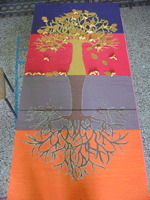
EVALUATION
![]() Understanding a work of art, both literary and visual, in a dynamic way, as something ‘alive and speaking’, which brings with it messages to cipher and which can be read and interpreted in many different ways.
Understanding a work of art, both literary and visual, in a dynamic way, as something ‘alive and speaking’, which brings with it messages to cipher and which can be read and interpreted in many different ways.
![]() Understanding the ability of the environment to speak and recount its stories.
Understanding the ability of the environment to speak and recount its stories.
Sabrina Batino. Castiglione del Lago, IT















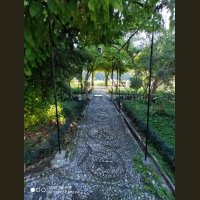
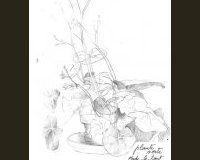

 Version imprimable
Version imprimable
